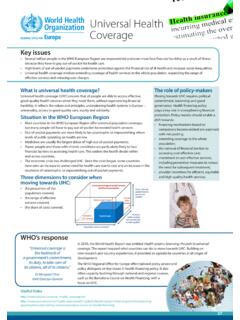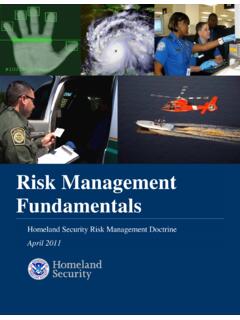Transcription of Preventing youth violence and gang involvement - GOV.UK
1 Preventing youth violence and gang involvement Practical advice for schools and collegesUsing this documentThis advice is for leaders, their senior teams and staff in schools or colleges in areas affected by gang or youth violence . When developing an approach, it is recommended that schools and colleges discuss ways to address youth violence with local police and community safety partners, as well as other local educational What does the law say about youth violence and teachers powers? Preventing violence Understanding the issue Seeking support Working with other local partners to address the issuePrimary schools and early interventionRisk factors What works in Preventing violence in schools and colleges Who to involve Evidence on general approaches Sources of evidence Assessing specific programmes Targeting a programme, or developing a new one Resource A: Legal powers Staff powers Joint enterprise Gangs, firearms and knives Resource B: What works in Preventing violence and aggressive behaviour?
2 Resource C: Repositories of evidence (evaluated and new/developing programmes) and other resources for schools Resource D: How do you know if a programme has been effective in the past? Resource E: What if there is no specific evidence, or the programme is new?4891720233038404 IntroductionThe vast majority of young people and education establishments will not be affected by serious violence or gangs. However, where these problems do occur there will almost certainly be a significant , both primary and secondary, and colleges have a duty and a responsibility to protect their pupils and students. It is also well established that success in learning is one of the most powerful indicators in the prevention of youth Dealing with violence also helps pupils and students generally see educational establishments as safe places, even low levels of youth violence can have a disproportionate impact on any educational establishment.
3 Schools and colleges are places where important interventions can take place to prevent negative behaviour, such as young people carrying a schools are also increasingly recognised as places where early warning signs that younger children may be at risk of getting involved in gangs can be spotted. Crucial preventive work can be done at this stage to prevent negative behaviour from escalating and becoming entrenched. Programmes such as Families and Schools Together, Positive Action or the Good Behaviour Game are aimed to improve social and emotional skills, understanding risk, exploring how to stay safe and make safe choices. Whilst schools and colleges may face different specific challenges and operate in different contexts, many of the issues they face will be schools specifically, one of the four key judgements that Ofsted inspectors will make is on the behaviour and safety of pupils.
4 In order for a school to be judged outstanding , all groups of pupils must: feel safe at school all the time; understand very clearly what unsafe situations are; and be highly aware of how to keep themselves and others will include a consideration of pupils ability to assess and manage risk appropriately. This explicitly includes online safety, substance misuse, knives and gangs, and relationships (including sexual relationships).Ofsted inspectors also judge schools on pupils behaviour towards, and respect for, other young people and adults. This includes freedom from bullying, including cyber-bullying, harassment and discrimination. Assessment of schools will focus on bullying related to special educational needs, sexual orientation, sex, race, religion and belief, gender reassignment, or disability, as defined in the Equality Act violence in schools and colleges can require a mix of universal, targeted or specialist interventions.
5 School and college leaders should be able to: develop skills and knowledge to resolve conflict as part of the curriculum; challenge aggressive behaviour in ways that prevent the recurrence of such behaviour; understand risks for specific groups, including those that are gender-based, and target interventions; safeguard, and specifically organise child protection, when needed; carefully manage individual transitions between educational establishments, especially into Pupil Referral Units (PRUs) or alternative provision; and work with local partners to prevent anti-social behaviour or crime. Crucial preventive work can be done at this stage to prevent negative behaviour from escalating and becoming entrenched, such as programmes aimed to improve social and emotional skills or programmes which help children understand risk and make safe guidance, which has been produced as part of thecross-Government work on Ending gang and youth Violence3,is intended as a resource upon which schools and collegescan draw.
6 It includes: advice on the support available to address problems of youth violence or gangs; a summary of what works in Preventing violence ; some considerations when commissioning programmes to improve outcomes for young people; and a set of resources and practical guidance signposts school and college staff to resources: providing the skills and support to help young people to resist becoming involved in violence ; identifying young people in need of help; and working with other agencies to tackle have a range of powers in relation to discipline. These are there to protect teachers as they tackle problems, including violence , in the school environment. Such powers cover disciplinary actions, the power to restrain violent pupils, and the power to search pupils for prohibited items. There are also some legal issues that teachers should be aware of that relate to gang membership, in particular concerning the potential criminal liability of young people whose presence or actions lead to a crime, even if they did not commit the crime themselves ( joint enterprise ).
7 This highlights the risks for young people of gang involvement , even if they think that they have not directly committed any crimes. An overview of the relevant powers and legislation is attached at Resource A. What does the law say about youth violence and teachers powers?9 Preventing violence9In order to tackle violence affecting schools or colleges and the community, it is important to: understand the problems that young people are facing both in school/college and in their local community; consider possible avenues of support; and work with local partners (who may have valuable information, resources or expertise). Leaders and senior teams in schools and colleges should also recognise that early intervention includes anti-bullying and a curriculum that ensures that young people develop the social and emotional skills they need in order to meet their full potential. For example, the curriculum should include teaching conflict resolution skills, understanding risky situations, and violence and abuse should be clearly defined so that young people know when to seek help.
8 Understanding the issueIt is important to understand fully the issue or issues that affect the local area. In-depth analysis of the issues should highlight areas for action by bringing together information about: the scale and nature of youth violence ; who is involved; what may already be in place to help young people; and where there may be gaps. Engaging with the local community safety partnership, the youth offending team, the Safer School Partnership officer or the neighbourhood police team can assist schools if there is a gang or youth violence problem in their area. Introduction10 Working with local partners will help to achieve a full understanding of the context that school and college staff work in, especially how community issues affect behaviours in the school or college. Additionally, school councils may offer an opportunity to engage with pupils on this part of their emergency management planning, schools should have in place systems for targeting and responding to individual or group violence .
9 Even if violent incidents themselves do not appear to be an immediate concern, there may be a need to build resilience to such problems for the future. Seeking supportParents, carers, family members and other adults in children s lives such as teachers have an incredibly important role to play in helping protect them from gangs and to keep them away from violence . But it can be difficult to know what to do. Anyone worried about a child or young person involved in, or at risk from, gangs can call the NSPCC helpline on 0808 800 5000. Helpline practitioners have been trained as part of the Home Office Ending gang and youth violence programme, and can offer advice, support and information on what action to take to help young people who are in, or at risk from, a headteacher networks are the most common way to share ideas, practice and support. Schools can link with local support groups and specialist agencies with experience in dealing with gang -related issues.
10 If the school or college is in an Ending gang and youth violence priority area4, there is likely to be someone with a role in relation to gangs who will be in a position to provide specialist support within either the local authority or the police. Please see the information on community safety partnerships in Working with other local partners to address the issue below. 11 There is also a range of resources on what works. These are outlined below in the section on Sources of Evidence. The Department for Education (DfE) has published a range of advice on behaviour, attendance and bullying. For example, the Government s former expert adviser on behaviour, Charlie Taylor, has produced a checklist on the basics of classroom Teachers can use this to develop between five and ten essential actions to encourage good behaviour in pupils. The Department for Education has produced advice for parents (November 2014) on how to protect their child from being cyber-bullied.

















